Saint of the Day – 9 August – Blessed John of Salerno OP (c 1190-1242) Dominican Friar and Priest, Confessor, Defender of the Faith, Superior with outstanding administrative and fatherly skills, miracle-worker, Pope Gregory IX commissioned him to deal with the heretical sect known as the Patarines – born in c 1190 at Salerno, Italy and died in 1242 of natural causes.
Although Father Touron failed to give a sketch of this distinguished Friar Preacher in his First Disciples of Saint Dominic, it is certain that he belonged to them and that he was an outstanding character in the noble galaxy. Some authors say that John was a scion of the noted Guana family and connected with the Norman princes who long reigned over the former kingdoms of Naples and Sicily. Whilst they do not give the date of his birth, practically all hold that he first saw the light of day at Salerno, some thirty miles south of Naples; that he studied at the University of Bologna and that he entered the Order in that educational centre. With one or two exceptions who give this honour to Blessed Reginald of Orleans, the writers maintain he received the habit from Saint Dominic himself. The year 1219 is the date assigned for the ceremony.
Evidently John was then a mature man, for he was soon placed at the head of twelve other confrères sent to establish the Order in Florence. A few date this commission in 1219 but 1220 is the time ordinarily given. The choice of him for superior, in so important a city, confirms the statement that his rare virtue, which he had practiced from early youth, made a strong impression on Saint Dominic. Although very small of stature, the future blessed, possessed a mighty mind and a courage that nothing could awe. Doubtless these qualities also appealed to the holy father, who seemed to judge of the characters ‘ of men almost by intuition, for an able, fearless leader was needed in Florence. Dominic and John are said to have been intimate, trustful friends-no doubt, a relationship born of grace. That the Saint formed a correct estimate of his young disciple, is shown by the fact that, our blessed soon became one of the most influential Friar Preacher in Italy.
A curious story is told about the first house of the fathers at Florence. It was built, so it would seem, by one Deodate del Dado (possibly a merchant) who wished to make restitution for his dishonesty by devoting it to religious purposes. Situated in the “plain of Ripoli”, two or three miles from the city limits, on the way to Arezzo, it was better suited for a contemplative order than for one of the apostolic character of Saint Dominic’s. Mamachi thinks another community had occupied it. Be that as it may, it was free when the builder beard of the wonderful preaching of the holy man from Caleruega, in Bologna. So he hurried to that city, attended one of the Saint’s sermons and then offered the place to him. Some writers say that the offer was accepted at once and the delighted donor accompanied the first missionaries back to Florence.
When the fathers arrived at the hermitage of Ripoli and saw its lonely, remote location, some of them likely wondered if their prayerful, mortified superior might intend to sacrifice the active side of their institute, which they had seen brought so prominently to the fore in Bologna, to the retired and cloistered side. They did not have long to wait before learning his views. Although the house was small, John of Salerno felt that it would suffice for a start. The first few days he spent in setting the place in order. Then he called the community together, and made known his plan of action. The life of a Friar Preacher, he said, is that of an energetic apostolate. They had come to humble Hipoli, not for their own sakes but for the spiritual welfare of the faithful in the Province of Tuscany. The work would commence on the morrow and every man would be expected to do his duty.
Day by day, the little handful of soul harvesters left their hermitage at an early hour, in bands of two, that they might preach the word of God in Florence or elsewhere. In all thing,s the diminutive superior, with a great mind and magnanimous soul, set the example, as well as led the way, which he would have the others follow. They assembled the people in churches, public squares, market places, open plains — wherever they could procure an audience. In the evening, unless too far away, they returned to their quiet abode for prayer and meditation.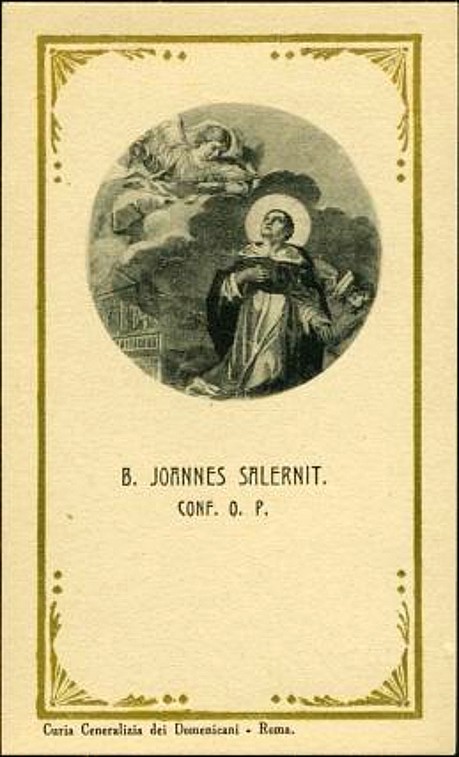
Proud, cultivated Florence was stirred to the very core by the eloquence and zeal of the new religious, in whose lives there seemed to be naught of the worldly. The effect of their sermons was enhanced by the patience with which they trudged afoot back and forth between Ripoli and the city. They were on every tongue-in every mind. Their preaching was discussed in public, no less than in private. Repentant Deodate seems to have taken care of their secluded home while they were absent, as well as to have contributed towards their maintenance. No doubt he was happy in the realisation that his work of reparation bore such rich fruit.
Among the band of missioners, men of God though they all were, John of Salerno shone especially for his oratory, virtue and quest for souls. None of them appeared quite so heroic as he. Whilst his example, fatherly government and kindly admonition ever urged his confrères on in their exertions, his fine judgement and tact won the confidence of the faithful. All this combined with his superb scholarship and rare devotion to bring him the affection of the Archbishop, John di Velletri, together with that of the vast majority of the Diocesan clergy. Indeed, our Friar Preacher had every qualification for a perfect superior and a successful fisherman of men. Thus, it is no matter for wonder, that he was retained at the helm of his Order in one of Italy’s most beautiful cities, yet ever a maelstrom of political intrigue.
Saint Dominic is said to have been so impressed with the reports of the good’ effected by his brethren in Florence, that he paid them at least one visit and was delighted with their fervour and zeal. Their benefactor, Deodate, seems to have lived less than a year after they settled in his hermitage. His death deprived them of their principal source of support. This misfortune, together with the fatigue of walking back and forth each day between the city and the “plain of Ripoli,” caused the Florentines to obtain permission for them to use the hospice of Saint Pancratius, which stood at the side of the Church of the same name within the municipal limits, until a more suitable place could be obtained for them. John of Salerno gladly acceded to the proposal and moved his community thither at once, for this more convenient location would be of great aid to his friars in their work.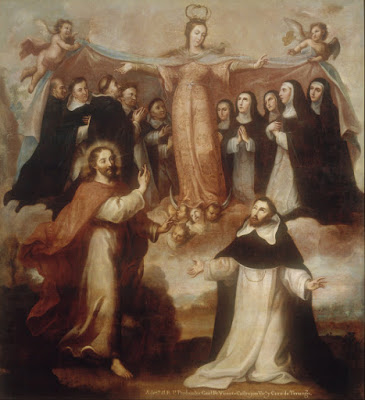
From the Saint Pancratius’ house, the fathers were soon transferred to Saint Paul’s. There, however, as was but natural, objections against their presence were raised by the clergy stationed at that church. John and his companions, while continuing their labours, bore all difficulties with admirable patience. Fortunately, no doubt in answer to their prayers, providence came to their aid. A Father Foresio, rector of Santa Maria Novella, touched by their virtue, zeal and forbearance, offered them his Church, together with the buildings attached to it, on condition that they would pay a moderate allowance each year for his support. Our blessed, in his capacity as superior, gratefully accepted the generous offer. Cardinal Ugolino, the Papal legate whom we have so often seen in the role of a friend of the Order and Archbishop di Velletri warmly approved of the project.
Santa Maria Novella passed into the hands of the Friars Preacher, on 8 November 1221. Thus John of Salerno became the founder of the great convent at Florence, which was destined to become one of the most historic and beautiful, in a religious institute, renowned for it’s learning and deeds, as well as for its cultivation of the artistic. Many noted clergymen were trained and educated there. Not a few of Italy’s most famed painters, sculptors and architects were employed there. It is still an object of delightful study for artists from every part of the world. Because of it’s exquisite decorations, Michaelangelo was wont to call it “The Bride.”
Florence had become one of the strongholds of the new Manicheans in Italy, whence their evil influence spread throughout Tuscany. They hesitated at nothing for the propagation of their destructive principles. In the subject of our sketch they met with a relentless foe. Day and night he opposed them, whether by deed or word. Never was he known to quail before their threats or attacks. His fearless action and preaching not only produced the most salutary effects but even won for him, the name of “hammer of heretics.” He must ever rank high amongst those brave Friars Preachers who helped to free the Italian Peninsula from the dangers of Manicheanism and Albigensianism.
The persuasive eloquence of the man of God, combined with the odour of his sanctity and the fire of his zeal, drew many and brilliant subjects into his Order. They came from numerous places but especially from Florence, Prato and Pistoia. 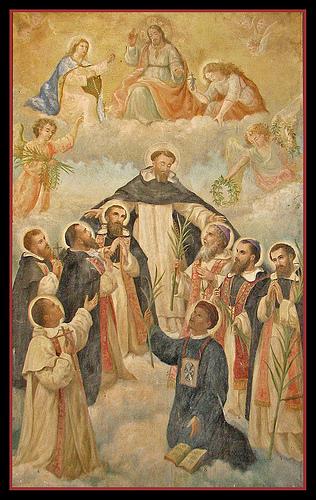 Among them was the noted Hugh of Sesto, a Canon at Saint Paul’s who had led the opposition to the friars at that church. Others who should not be omitted were – Roderic, a Canon at Saint Peter’s, James Rabacante, who later succeeded John of Salerno as Prior of Santa Maria Novella, Ottavente di Nerli, Roger Calcagni, who became the first Papal inquisitor at Florence and Bishop of Castro; Father Buoninsegna, a Martyr at Antioch, who is commonly called blessed, Ambrose of Rimini, a celebrated preacher who became Bishop of his native city, Thomas Morandi, honoured with the mitre of Fano and Aldobrandini Cavalcanti, entrusted with the charge of the Diocese of Orvieto. We might mention more but those given above suffice to show the character of those whom the early disciple brought into his institute.
Among them was the noted Hugh of Sesto, a Canon at Saint Paul’s who had led the opposition to the friars at that church. Others who should not be omitted were – Roderic, a Canon at Saint Peter’s, James Rabacante, who later succeeded John of Salerno as Prior of Santa Maria Novella, Ottavente di Nerli, Roger Calcagni, who became the first Papal inquisitor at Florence and Bishop of Castro; Father Buoninsegna, a Martyr at Antioch, who is commonly called blessed, Ambrose of Rimini, a celebrated preacher who became Bishop of his native city, Thomas Morandi, honoured with the mitre of Fano and Aldobrandini Cavalcanti, entrusted with the charge of the Diocese of Orvieto. We might mention more but those given above suffice to show the character of those whom the early disciple brought into his institute.
Blessed John had a special gift for governing others. He seemed to read dispositions almost as he would read a book. In all things he showed himself a father, brother, friend and servant to those under his charge. He dominated their wills by kindness, quickened their zeal by his own, directed them along the path of perfection by his example and gentle words. The love which he bore them merited the affection which they gave him.
Whatever he did, the man of God was doubtless guided by the lessons which he had received from Saint Dominic. He had lived under the our blessed Dominic at Bologna, had met him in Florence and, of course, had come in contact with him at the general chapter of 1221. Some writers say he was the Saint’s travelling companion on several apostolic journeys. However, such was his love for the Order’s Founder that he no sooner received word of his serious illness, than he started in all haste for Bologna, where he arrived just in time to receive the dying man’s last blessing and the assurance that he would be more helpful to the infant institute in heaven than he could be on earth. Such is the importance which one saint attaches to the word of another, that we are justified in believing those of Dominic must have acted as an inspiration for Blessed John of Salerno the rest of his life.
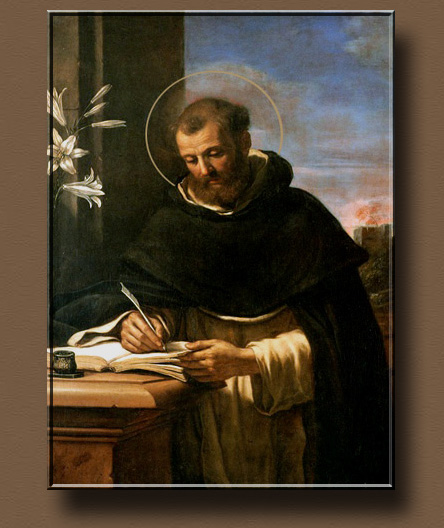
God enriched the soul of this early disciple with many choice graces. One of the things which greatly aided him in the spiritual direction of others, whether in his Order or without it, was the faculty often accorded him of reading their consciences. Many a time did he make known to his penitents, sins which they had forgotten. This gift, quite naturally, increased his influence and he was careful to use it only for the spiritual betterment of those who sought his aid. Not a few miracles were also attributed to him but these he did all in his power to conceal.
There is an adage which tells us that the ways of God are not the ways of man. Rare is it, that providence does not permit even the most faithful servants of Christ to be tried in the crucible of temptation but, as Saint Paul assures us, the temptation is always accompanied with the grace necessary to overcome it. So it was with John of Salerno. There were those who sought to lead him from the path of virtue. Yet his resistance not merely saved him from sin, it issued unto his greater glory before God and man. It made him “the good odour of Christ” even unto the conversion of those who thirsted for his ruin.
Among our Friar Preacher’s notable works for the benefit of religion in Tuscany must be placed the establishment of the first community of Dominican Sisters in the province. These he started in the hermitage of Ripoli, built by Deodate del Dado, sometime after the fathers had left it. He had great faith in the prayers of these holy women and trusted to their intercession as an aid to the success of his work and that of his friars. In later years, because the neighbourhood of Florence became infested with brigands, these sisters moved into the city. There, they divided into two communities. One of them retained the old title of Ripoli, while the other took the name of Saint Dominic. Both long continued to edify the Florentines by their saintly lives and to bring blessings on the Church of the municipality by their perpetual prayers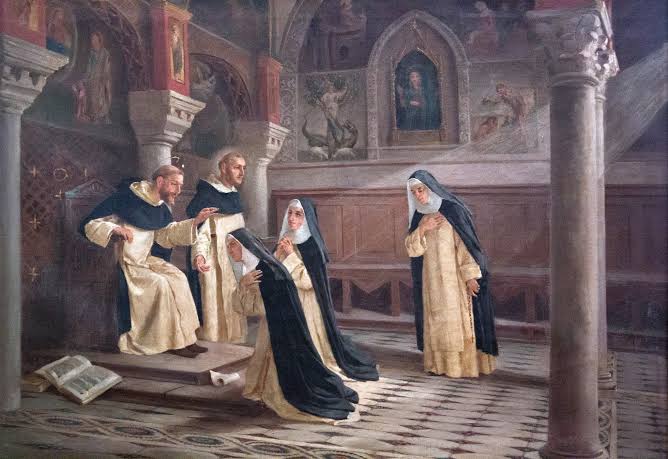
So laboured on Blessed John of Salerno until the end of his useful life. Father John Caroli and other earlier writers speak of his toil and his heroic virtue in terms of the highest praise. They tell how he was loved and venerated, how his fellow friars mourned his death and how the people of Florence turned out in a body for his funeral but, they give us no further indication of it’s date, than to say that it happened after many years of faithful labour.
Our blessed was buried with great honour in the Church of Santa Maria Novella, where his tomb immediately became a place of pilgrimage for the faithful. A number of miracles were attributed to him. It would seem that there were several translations of his relies, one of which doubtless took place when his body was removed from the old church to the new. On these occasions the faithful of the city and neighbouring places came in immense crowds to pay honour to one, whom they held in deep veneration. The last and possibly the most notable, ceremony of the kind took place on 18 February 1571. At this date his relics were placed in a tomb and chapel specially dedicated to his memory. Pope Pius VI, who reigned from 1775 to 1799, officially ratified the cult to John, permitted his Order to say Mass and the Divine Office in his honour and appointed 9 August as his feast day.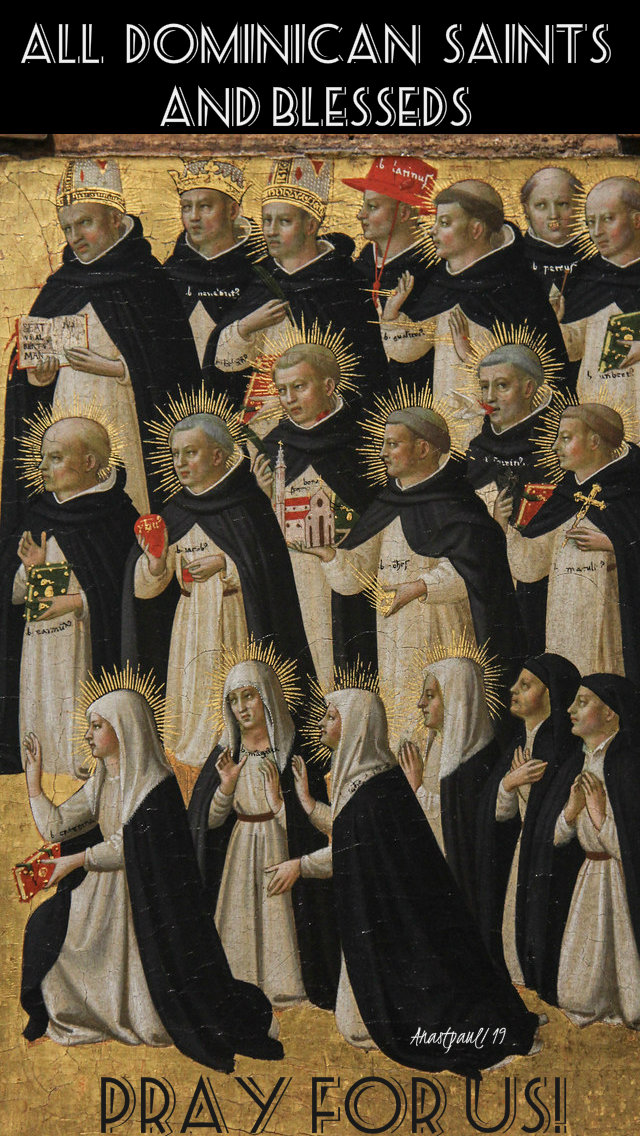
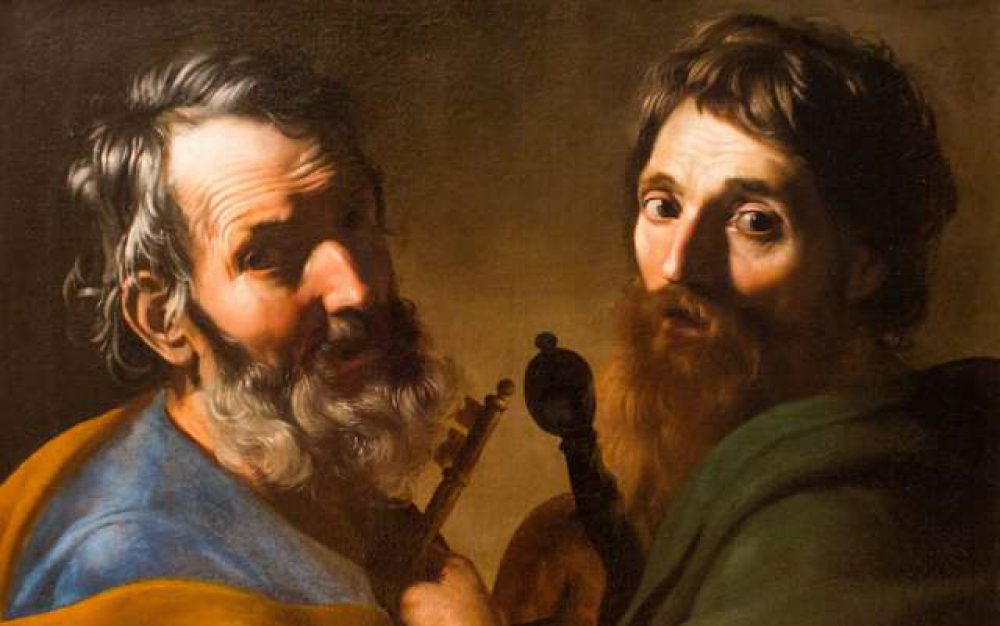
Here’s another excellent, in-depth write-up of a saint not often talked about. Thanks for posting and getting this lamp out into the open. 👇👆👍✌️✊
LikeLiked by 1 person
Thanks Stacy – yes it saddens me that so many of our heavenly friends await our call and no-one calls.
LikeLike